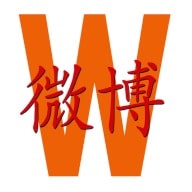Featured
China’s 2018 New Marriage Law? Online Discussions on ‘Three Child Policy’ and Lowering of Marriage Age
Alleged changes to China’s marriage law have set rumors going on Chinese social media about a ‘three-child policy.’
Published
7 years agoon

Alleged changes to China’s marriage law have ignited discussions on Chinese social media about a ‘three-child policy’ and a lowering of legal marriage age to 18. Although “it’s all just rumors”, many netizens already raise their voices against such potential changes, saying it would pressure and burden Chinese women even more.
China’s ‘New Marriage Law’ (新婚姻法) has become a topic of discussion on Chinese social media over the past few days, where many netizens have started talking about an alleged “Three Child Policy” and a lowering of China’s legal marriage age to 18.
The New Marriage Law was passed in 1950 as one of the first pieces of legislation passed by the People’s Republic of China (PRC). Mutual consent to marry and a heightened legal age to marry to 18 (for women) and 20 (for men) were among the important points stipulated in this legislation.
In the Marriage Law of 1980, this was again raised to 22 for men and 20 for women to promote population control.
Throughout the years, there have been various legal changes in the Marriage Law or in its interpretation, to deal with emerging marriage and family issues in a rapidly changing Chinese society.
Three Child Policy?
Over the past few days, various Chinese bloggers (e.g. here, here, here) suggest that Chinese authorities are putting forward a 2018 renewed Marriage Law, which includes the alleged proposal of a loosening of the two-child policy towards a ‘three-child policy’ (“放开三胎政策”).
These bloggers and many netizens denounce such a potential measure in saying that an extension from the Two-Child Policy to a ‘Three Child Policy’ would add to the burden of Chinese women.
Such a policy, they argue, might lead to Chinese women facing social expectations to birth a third child. And with supposed longer maternity leaves, they would also face unequal opportunities in the employment market.
When the ‘Two-Child Policy’ was officially announced in 2015 as the new national standard (全面二孩), allowing all Chinese couples to have two children instead of the one-child rule that was the norm since 1979, there were also concerns about the economic and gendered pressures of having a second child.
The end of the One Child Policy relates to the growing societal burdens of China’s aging crisis; many demographers proposed a further liberalization of the Chinese family planning system before.
But according to a Chinese Law site (66law.cn), news about an alleged ‘Three-Child policy’ is all just rumors: “Recently, online rumors about the three-child policy to be implemented in 2018 have grown. We live in a populous country, and if this three-child policy would be implemented, it would only add to the pressure [of this big population],” they write, adding that there is “no truth” to the reports.
The rumors find their root in the parliamentary sessions of March, when, as SupChina notes, a proposal drafted by a deputy named Zhu Lieyu (朱列玉) to the National People’s Congress made headlines for suggesting that a three-child policy might be adopted nationwide.
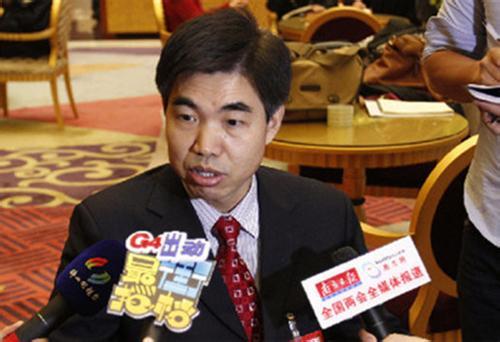
Zhu Lieyu (朱列玉): proposing a ‘three child policy’
“If China’s birth rate doesn’t see a rise after a three-child policy, we should consider ending any sort of family-planning policy,” the deputy reportedly told Chinese reporters.
Marriage Age to 18
The idea to lower China’s marriage age from the age of 22 for men and 20 for women to 18 years old is something that has already been proposed since last year.
In 2017, National People’s Congress deputy Huang Xihua (黄细花) called for lowering China’s legal marriage age. At the time, many people on Weibo were not happy about the proposal – with some finding it outright shocking.
Netizens then expressed that they were afraid that such a measure will negatively affect the status of women in Chinese society and increase the nation’s divorce rates. “Won’t this lead to a drop in the percentage of women with a higher education?”, some wondered.
The potential lowering of the legal marriage age, a big trending topic in 2017, is still a source of concern for Chinese netizens now. “This is just a way to make us have more babies!” some say.
“We can’t draft a law based on gossip.”
Despite all talks on social media and blogs, China’s official state media have not released news about any new changes to the legislation yet. “Where is this official launch of the New Marriage Law?”, one female netizen (@澄明居-許振雲) wonders: “We can’t draft a law based on gossip!”
“WeChat accounts are one by one publishing about the New Marriage Law,” another commenter writes: “But there’s nothing here yet – it’s just WeChat users making up their own laws.”
“I actually still hope that we can be open to having three children [in the future],” one female netizen responds: “It will be nice for those who are capable of doing so, and people who like have more children. It’ll also ease the worries on the collapse of the social insurance [system] of those of us who are not having children. Those who want to can have children, and those who do not want to, do not need to. Then we’ll find the middle way in a developing nation.”
Others say such a measure would only add to the pressure of women in China today: “We have 30 million leftover men,” another commenter writes: “The more women’s lives are pressured and the more the value of women’s contribution to family life is neglected, the more females will be afraid to get married.”
By Manya Koetse, with contribution from Diandian Guo.
Follow @whatsonweibo
Featured image is part of a larger poster that can be viewed on the website https://chineseposters.net/themes/marriage-law.php.
Spotted a mistake or want to add something? Please let us know in comments below or email us.
©2018 Whatsonweibo. All rights reserved. Do not reproduce our content without permission – you can contact us at info@whatsonweibo.com.
Manya is the founder and editor-in-chief of What's on Weibo, offering independent analysis of social trends, online media, and digital culture in China for over a decade. Subscribe to gain access to content, including the Weibo Watch newsletter, which provides deeper insights into the China trends that matter. More about Manya at manyakoetse.com or follow on X.
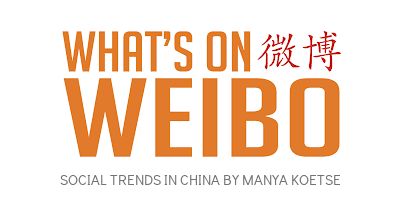
You may like
Dear Reader
No Quiet Qingming: From High-Tech Tomb-Sweeping to IShowSpeed & the Seven China Streams
It’s been a week where rituals met robots, IShowSpeed’s China streams got an upgrade, and quiet was nowhere to be found.
Published
1 day agoon
April 6, 2025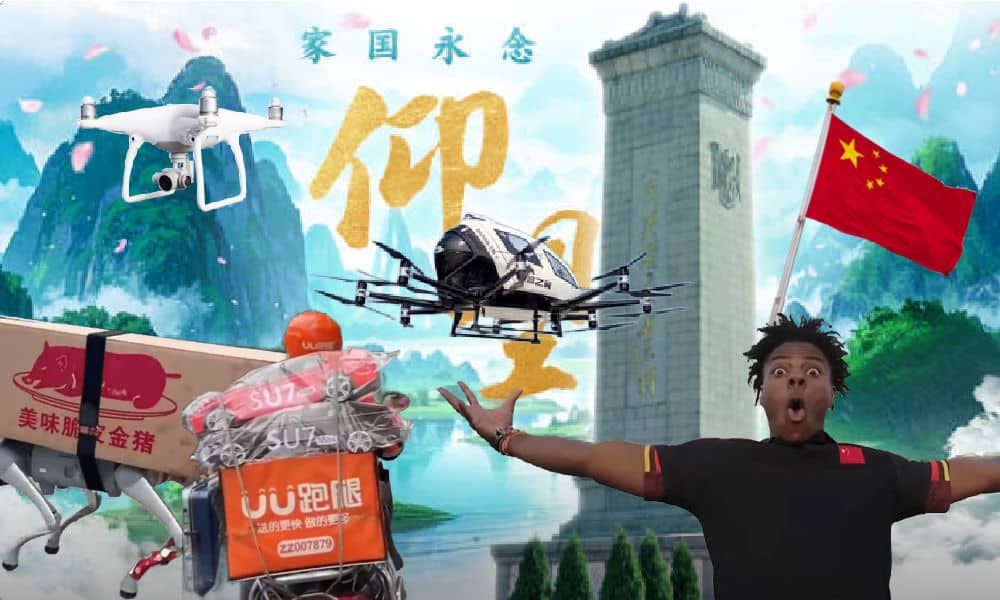
FROM THE WEIBO WATCH PREMIUM NEWSLETTER
Dear Reader,
It’s been a tumultuous news week, with discussions and trending topics on Chinese social media going from international events like the Myanmar earthquake or the impeachment of South Korean (former) President Yoon Suk Yeol to major discussions on the safety and abuse of the autopilot feature on electric vehicles, the US trade war, and new military exercises around Taiwan.
🧹 With so much going on, this year’s Qingming Festival (清明节) felt especially welcome. Also known as Tomb-Sweeping Day, Qingming fell on April 4 this year. It is a special time to reflect, pause, and honor family ancestors by visiting graves, making offerings, and burning spirit money.
🧳 It’s also a public holiday and a popular time for travel. And so, instead of a quiet time, many popular tourist spots across China turned into a sea of people. One example is Qingdao, where the famous Zhanqiao Pier (栈桥) — the one featured on the Tsingtao Beer label — became more people than pier. That crowded hotspot scene sparked the trending hashtag “#人人人人栈桥人人人人#”: People-People-People-People-Zhanqiao-People-People-People-People.
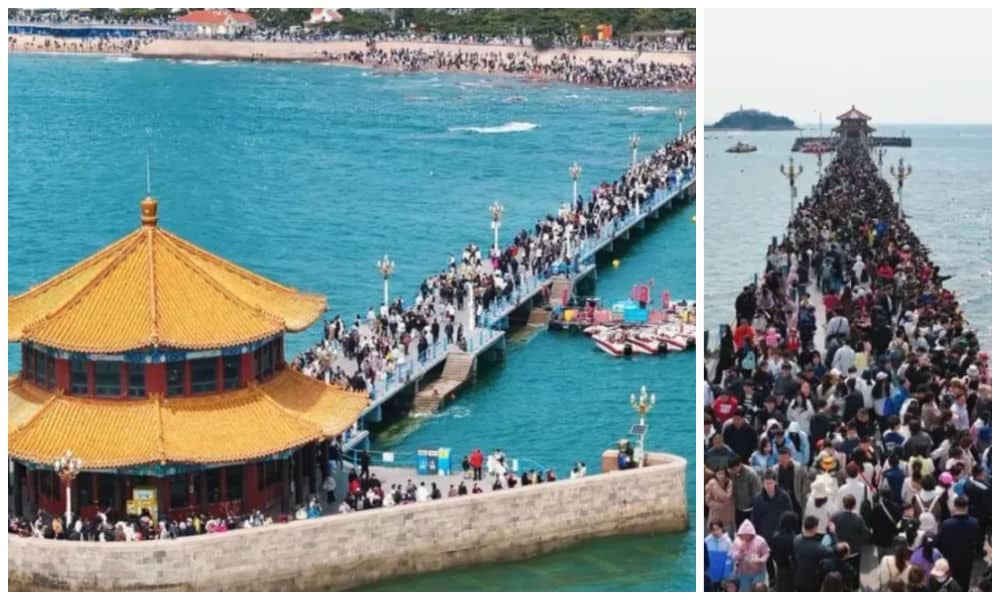
More people than pier in Qingdao, images via Qingdao Daily 青岛日报
On Chinese social media, it has become somewhat of a tradition to post about just how busy it is at China’s various sightseeing spots. This is often done using the hashtags “人人人人[place]人人人人” or “人人人人[me]人人人人.” The character 人 (rén) means person or human; “人人” (rénrén) means “everyone,” and the more “人人人” (rén rén rén) are used, the more it playfully emphasizes the crowds of people.
Since it was also very crowded this weekend at Hangzhou West Lake, Mount Qingcheng, the Longmen Grottoes, the Hubei Provincial Museum (people lining up to see the Sword of Gouijan), and many other places, there were similar hashtags for various places going around Weibo.
📰 Qingming Festival is also a busy time for state media, as the holiday ties into broader narratives about the nation and remembering those who defended the homeland.
State media-initiated hashtags like “Forever Remember [for] the Homeland, Salute to Our Heroes” (#家国永念致敬英雄#) are used in posts about key commemorations — such as the China Coast Guard observing a moment of silence facing the sea and scattering flowers in honor of China’s martyrs.

CCTV poster 家国永念, Always Remember [for] the Homeland.
One especially notable grave visit covered by the media this weekend was that of Mao Xinyu (毛新宇), the only surviving grandson of Mao Zedong. He returned to Mao’s birthplace, Shaoshan, with his family to pay tribute to his grandfather. At the statue of Mao, great-granddaughter Mao Tianyi (毛甜懿) also spoke a few words, wishing her great-grandfather peace and expressing hope that she could live up to his expectations (see video).
💸 For China’s paper offering businesses, the period around Qingming Festival is anything but quiet. Over the past years—and especially in the age of booming e-commerce—the ancient ritual of paper offerings has undergone major transformations and become increasingly extravagant. By burning ritual paper gifts, it’s believed that these offerings are sent to the afterlife.
To please the ancestors—and perhaps sometimes to impress the neighbors, too—people now burn all kinds of things, from paper liquor to cardboard Rolex watches. Some take it a step further, creating entire paper replicas of two-story villas or palaces to honor their ancestors. Chinese media reported that one vendor in Jiangsu’s Nantong was selling a 200 m² paper villa, complete with rooms, for 15,000 yuan ($2,060)—it even had a car in the driveway (video)! Another video showed neighbors gathering to watch such a paper mansion go up in flames.
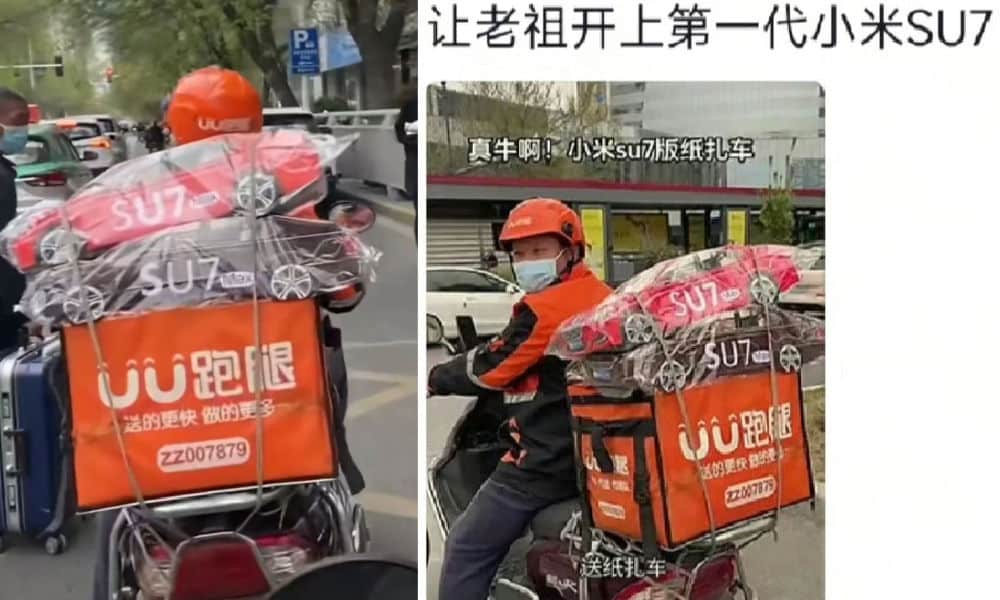
This year, one item that particularly caught attention on WeChat and Xiaohongshu was a paper version of the Xiaomi SU7 EV. A video showing these offerings strapped to the back of a delivery scooter went viral—apparently, Xiaomi is more popular than BMW this year (read last year’s article about Burning BMWs here).
🪦 At least for the people visiting their family’s graves and bringing offerings, Qingming should be a relaxing time, right? Not exactly — or at least, not for everyone. This year, the Qingming Festival ancestral worship activities of the “South China F3” (华南F3, referring to Guangdong, Guangxi, and Hainan) have sparked widespread discussion for just how dramatic and hardcore they can get.
Many people in these southern provinces, especially in rural and mountainous areas, have become known for going all out when it comes to ancestral worship during Qingming. Climbing mountains, entering caves, wading through rivers — some ancestral graves are so hidden that tomb-sweeping day feels more like a wilderness survival challenge for the families trying to reach them.
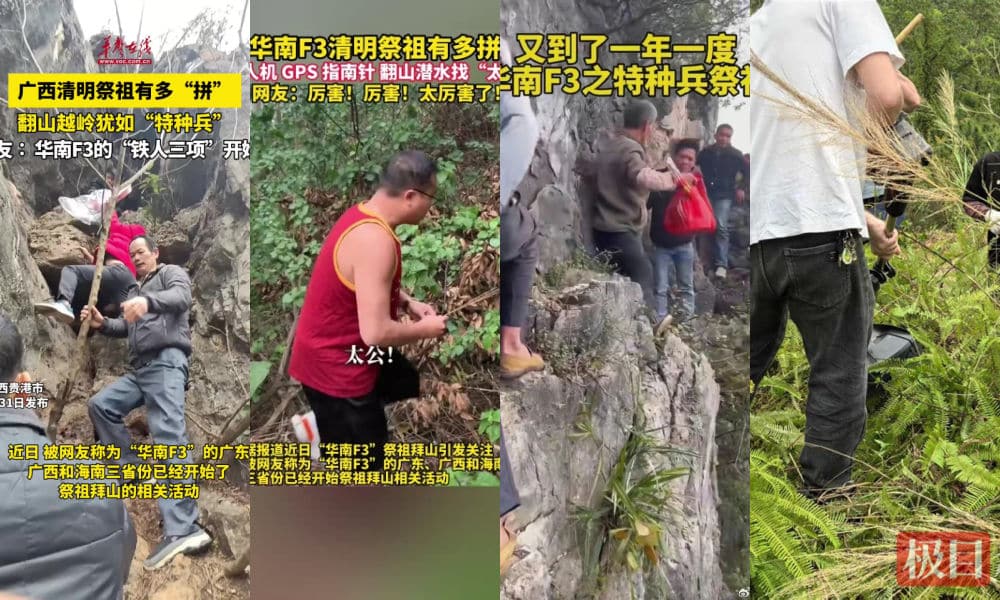
Tomb-sweeping days can feel more like a wilderness training for some in more remote and mountainous areas.
On Friday, Toutiao News reported that new technologies are now helping people pay respects when graves are located in remote, hard-to-access areas. Since 2021, one entrepreneur from Guangxi has been using drones to deliver offerings into the mountains. GPS apps help track routes to ancestral tombs, and robotic dogs are even being used to carry food and offerings up steep paths.
So while technology is making ancestral rites more efficient, it’s also adding new layers of intensity to rituals that perhaps were never meant to be fast-paced in the first place.
📱🐼 IShowSpeed and the Seven China Streams
Robots, drones, flying cars — they are not just becoming part of China’s old traditions, they’re also a major part of China’s new narratives, and this was particularly clear this week in the many hours of livestreaming by the famous American YouTuber IShowSpeed (Darren Jason Watkins Jr.).
After Shanghai, Beijing, and the Shaolin Temple in Henan, IShowSpeed continued to livestream from Chengdu, Chongqing, Hong Kong, and Shenzhen. His seven China streams together make up over 43 hours of footage, and I’ll admit that I’ve seen the great majority of it.
Last week, I already did a deep dive into the significance of IShowSpeed’s China tour, and how his streams have been used by Chinese official channels and state media as part of the strategy to tell China’s story well, and also to spread China’s message effectively — preferably through genuine and engaging stories. (In case you missed it, read the analysis here).
This week’s streams showed that both IShowSpeed’s team and the Chinese coordinators behind the scenes were even better prepared for the livestreamed visits and the enormous spectacle it brings to the places he goes. Some Chinese state media even started livestreaming his streams as well. In just ten days, Watkins has become a mega-celebrity in China, where he wasn’t that famous before — and he’s been trending on social media practically every day since March 24. Outside of China, his influence is also growing. During his Hong Kong stream, he reached a personal record of 38 million YouTube subscribers.
IShowSpeed is no longer just an American personality — he’s a marketing platform. Chinese authorities, state media, companies, brands, e-commerce channels, and influencers are all jumping in on the hype to benefit from his popularity.
From the top-down narrative perspective, his China tour has been a huge success. Kung fu performances, traditional opera, pandas, Chinese dance and music, local cuisine highlights, the Great Wall, traditional medicine and yin-yang, futuristic cities alongside ancient culture, high-speed rail, noodles, dancing aunties, and Shaolin monks — his streams became an ultimate representation of the Chinese cultural promotion playbook, and were reported on as such. China’s national broadcaster CCTV aired an entire 8-minute segment on his China tour, covering his adventures.
When Watkins’ livestreams started to include aerial drone footage with spectacular views — and especially when dancing with robots was added to the list of activities — I couldn’t help but see a resemblance between his 5+ hour stream and the famous Spring Festival Gala: a tightly programmed spectacle featuring Chinese opera, kung fu, and traditional cultural highlights mixed with cutting-edge technology.
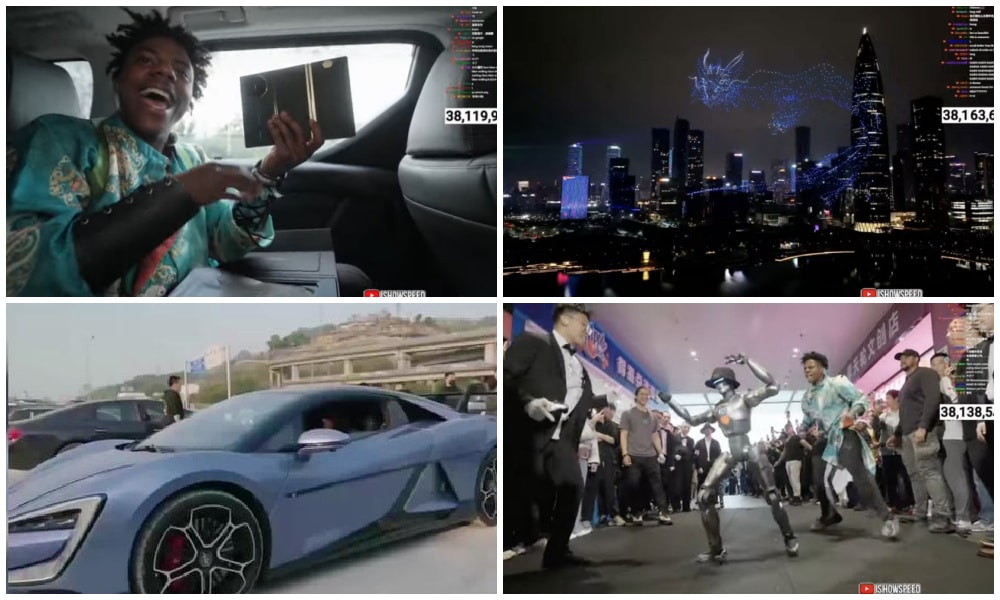
Watkins’ latest visit to Shenzhen especially became a celebration of Chinese tech. Not only did he do the robot dance and purchase three Huawei Mate X3 tri-fold phones (he also got futuristic BYD Yangwang U9 in Chongqing), the city had also organized a spectacular dragon drone show. Watkins also took a ride in a “flying car” — the EH216-S by tech company EHang (亿航). Just last week, EHang received official approval to operate the aircraft in China. While these flying vehicles will mainly be used for tourism and sightseeing at first, they’re expected to be part of low-altitude urban commuting in the future. Starting later this year, you’ll be able to try it out yourself in Hefei, where public tourism flights will begin.

No wonder the EHang team was thrilled with the exposure. Besides a cultural ambassador to China, IShowSpeed’s been the best brand ambassador they could’ve hoped for.
At the same time, Watkins is anything but quiet, and his chaotic streams haven’t exactly brought moments of reflection during this year’s Qingming Festival. Today is a free day for him, offering some peace and quiet — for him, his team, and the entire circus surrounding the tour.
Wishing you a calm Sunday! Check out the rest of the newsletter here (link coming soon).
Special thanks to Miranda Barnes for contributing to this week’s issue. As always, thank you for your support — and don’t hesitate to reach out with any questions or suggestions.
Best,
Manya
(follow on X, LinkedIn, or Instagram)
Spotted a mistake or want to add something? Please let us know in comments below or email us. First-time commenters, please be patient – we will have to manually approve your comment before it appears.
©2025 Whatsonweibo. All rights reserved. Do not reproduce our content without permission – you can contact us at info@whatsonweibo.com.
China Insight
From Trade Crisis to Patriotic Push: Chinese Online Reactions to Trump’s Tariffs
“This moment is the time to reflect on our unity. If we can choose domestic alternatives, we should.”
Published
2 days agoon
April 5, 2025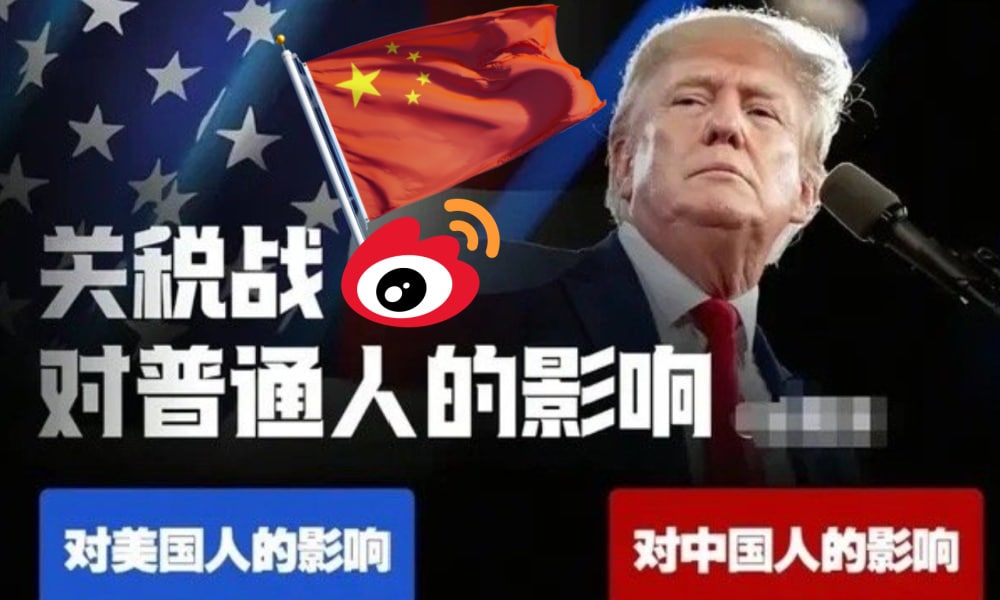
“China’s countermeasures are here” (#中方反制措施来了#). This hashtag, launched by Party newspaper People’s Daily, went top trending on Chinese social media on Friday, April 4, after President Trump announced steep new tariffs on Wednesday, including a universal 10 percent “minimum base tariff” on all imported goods and especially targeting China with an additional 34% reciprocal tariff as part of so-called “liberation day.”
Countermeasures were announced on Friday. China’s State Council Customs Tariff Commission Office (国务院关税税则委员会办公室) issued an announcement stating that, starting from April 10, an additional 34% tariff will be levied on all imported goods originating from the United States, on top of existing tariff rates.
Other countermeasures include immediate export restrictions on seven key medium to heavy rare earth elements, which are important for manufacturing critical products used in semiconductors, defense, aerospace, and green energy.
“This won’t make America great again”
The official response to the tariffs, both from state media and the government, has been twofold: on the one hand, it criticizes the U.S. for placing American interests above the good of the global community, arguing that the move only hurts the U.S., its people, and the world. On the other hand, the Chinese side stresses that although they do not believe tariff wars are the answer, China is not afraid of a trade war and will not sit idly by, but will respond with equal measures.
Chinese official media have condemned the new tariffs, which led to the largest single-day market drop in years. Describing the reactions of various experts, Xinhua News highlighted a comment by a Croatian professor, stating that the policy will only increase export prices and worsen inflation, ultimately hurting middle- and working-class Americans — and noting that the policy “won’t make America great again” (不会“让美国再次伟大”).
The official announcement by Chinese state media regarding China’s countermeasures received widespread support in its (highly controlled) comment sections, with both media outlets and netizens echoing the message that China will not be bullied by the U.S.
On Xiaohongshu, similar sentiments shnone through in popular posts, such as one person writing:
💬 “Congratulations to the U.S. on receiving a 34% tariff on all its goods! Luckily, very few of the things ordinary Chinese people eat or use come from the U.S. anyway.
#RMB purchasing power #China will inevitably be unified #Consumer confidence #Contemporary Chinese economy #Carrying forward the construction of a Beautiful China”
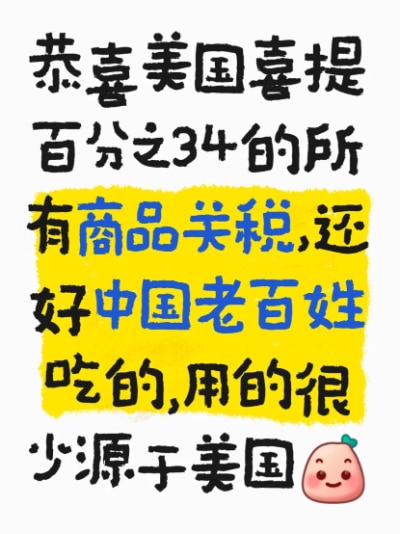
“Monday’s stock market will be a bloodbath,” another commenter wrote.
One Weibo blogger (@兰启昌) saw the recent developments as another sign of an ongoing trend of “de-globalization” (逆全球化).
But beyond global economics and geopolitics, many Chinese netizens — from Weibo to Xiaohongshu — seem more focused on how the new policies will affect everyday consumers.
Netizens have been actively discussing which goods will be hit hardest by the new tariffs. Based on 2023 trade data, here’s a breakdown of the top exports between China and the United States — and the sectors most likely to feel the impact.

🔷🇺🇸🇨🇳Top 10 Chinese Exports to the U.S.
1. Electronics and Machinery
Includes smartphones, laptops, tablets, integrated circuits, and image processing equipment.
2. Furniture, Home Goods & Toys
Such as video game consoles, lamps, and much more.
3. Textiles and Apparel
Garments, footwear, and accessories like sunglasses.
4. Metals and Related Products
Especially steel and steel-based items.
5. Plastic and Rubber Products
Widely used in packaging, manufacturing, and consumer goods.
6. Transportation Equipment
Electric vehicles, passenger cars, motorcycles, scooters, and drones.
7. Low-Value Commodities
Bulk items used in general trade and low-cost manufacturing.
8. Chemicals
Industrial chemicals and related materials.
9. Medical and Optical Instruments
Includes medical devices and precision instruments.
10. Paper Products
Ranging from office supplies to industrial paper goods.
🔹🇨🇳🇺🇸Top 10 U.S. Exports to China
1. High-Tech Machinery and Electronics
Especially integrated circuits, turbine engine components, and semiconductor manufacturing equipment.
2. Energy Products
Crude oil, liquefied propane and butane, natural gas, and coking coal.
3. Chemicals and Pharmaceuticals
Includes cosmetics, cleaning agents, and various medical drugs.
4. Soybeans
A key agricultural export widely used in food and animal feed in China.
5. Transportation Equipment
Such as automobiles and aircraft parts.
6. Medical and Optical Devices
Medical precision equipment, diagnostic tools, and lab instruments.
7. Plastic and Rubber Goods
Used in both consumer and industrial sectors.
8. Metal Products
Primarily iron and steel exports.
9. Wood and Pulp Products
Lumber, wood pulp, charcoal, and paper goods.
10. Meat
Including beef, pork, and poultry.
Those doing trade with the US, or otherwise involved in made-in-China products, like those working clothing and furniture factories, will inevitably be affected by the tariffs.
“Patriotism isn’t just a sentiment – it’s an action”
Much of the popular online conversation has focused on concrete examples of what kinds of things might get more expensive for Chinese consumers in their everyday lives.
Some bloggers noted that people might start to see price hikes in everyday groceries like dairy, meat, corn, and soybeans. With fewer soybeans coming in from the US, cooking oil prices may also rise.
China is the world’s largest consumer of soybeans, but because domestic production is relatively low, soybeans remain a key import.
Then there are popular American brands in the Chinese market that are expected to get pricier too — like beauty and health products, Starbucks coffee, or Häagen-Dazs ice cream.
Some also predicted a 30% to 40% increase in prices for iPhones and other Apple products.
Contrary to the earlier comment by the Xiaohongshu blogger, some netizens explain just how many American products are actually used by Chinese consumers, with many American companies operating in China — from McDonald’s and Coca-Cola, Walmart to Disney or Warner Brothers, Procter & Gamble to Colgate and Estée Lauder.
What’s noteworthy in these discussions, however, is a strong tendency to point to Chinese alternatives and encourage smart buying instead of following hypes (“理性替代,拒绝跟风”): No need to panic about soybeans — there are domestic alternatives, and China’s own soybean program is getting a boost. Who needs Starbucks when there’s Luckin Coffee? Why buy an iPhone when you can get a Huawei? Skip the Tesla, go for a BYD.
In these discussions, the ‘crisis’ is turned into an ‘opportunity’ for Chinese companies to focus even more on the Chinese market, and for Chinese consumers to, more than ever, actively embrace and celebrate local brands and made-in-China products.
One Chinese blogger (@O浅夏拾光O) wrote:
💬 “This moment is the time to reflect on our unity. If we can choose domestic alternatives, we should. For example, we can use rapeseed oil or peanut oil instead of imported soybean oil; we can buy cost-effective Chinese electronics instead of foreign brands. Support domestic products and respond to the nation’s call to expand domestic consumption.
We must have faith in our country. Only by uniting as one, young and old all together, the entire country working together, can we withstand all hazards. As Professor Ai Yuejin (艾跃进) once said, patriotism isn’t just a sentiment – it’s an action. As long as our core is stable and we are united in spirit, no hardship can defeat us.”
Despite the major happenings and the big words, some people just care about the small things: “As long as KFC and McDonald’s don’t raise their prices, it’s all fine by me.”
By Manya Koetse
(follow on X, LinkedIn, or Instagram)
Spotted a mistake or want to add something? Please let us know in comments below or email us. First-time commenters, please be patient – we will have to manually approve your comment before it appears.
©2025 Whatsonweibo. All rights reserved. Do not reproduce our content without permission – you can contact us at info@whatsonweibo.com.
Subscribe

No Quiet Qingming: From High-Tech Tomb-Sweeping to IShowSpeed & the Seven China Streams

From Trade Crisis to Patriotic Push: Chinese Online Reactions to Trump’s Tariffs

China Trending Week 14: Gucci Fake Lipstick, Xiaomi SU7 Crash, Yoon’s Impeachment

Strange Encounter During IShowSpeed’s Chengdu Livestream

IShowSpeed in China: Streaming China’s Stories Well

Our Picks: Top 10 Chinese Buzzwords and Phrases of 2024 Explained

“Dear Li Hua”: The TikTok/Xiaohongshu Honeymoon Explained

Beyond the Box Office: What’s Behind Ne Zha 2’s Success?

Weibo Watch: A New Chapter

15 Years of Weibo: The Evolution of China’s Social Media Giant

Tuning Into the Year of the Snake

IShowSpeed in China: Streaming China’s Stories Well

TikTok Refugees, Xiaohongshu, and the Letters from Li Hua

The ‘China-chic Girl’ Image and the Realities of China’s Competitive Food Delivery Market

“Black Myth: Wukong”: From Gaming Screens to the CMG Spring Festival Gala?
Get in touch
Would you like to become a contributor, or do you have any tips or suggestions? Get in touch here!
Popular Reads
-
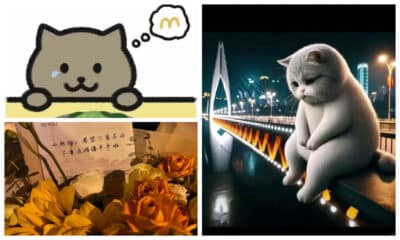
 China Insight11 months ago
China Insight11 months agoThe Tragic Story of “Fat Cat”: How a Chinese Gamer’s Suicide Went Viral
-

 China Digital10 months ago
China Digital10 months agoChina’s 2024 Gaokao Triggers Online Discussions on AI
-

 China Arts & Entertainment11 months ago
China Arts & Entertainment11 months agoSinging Competition or Patriotic Fight? Hunan TV’s ‘Singer 2024’ Stirs Nationalistic Sentiments
-

 China Arts & Entertainment12 months ago
China Arts & Entertainment12 months ago“Old Bull Eating Young Grass”: 86-Year-Old Chinese Painter Fan Zeng Marries 36-Year-Old Xu Meng
